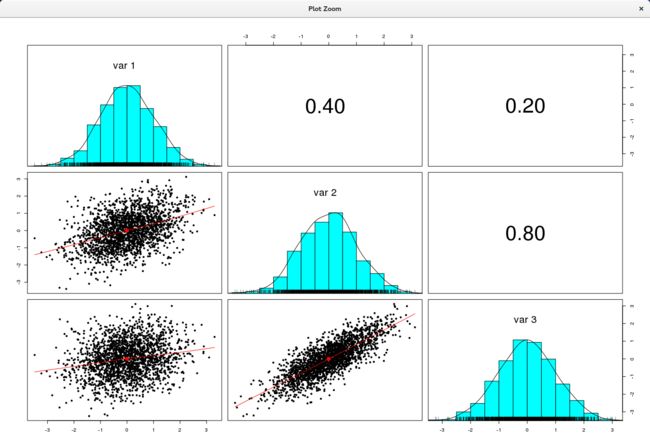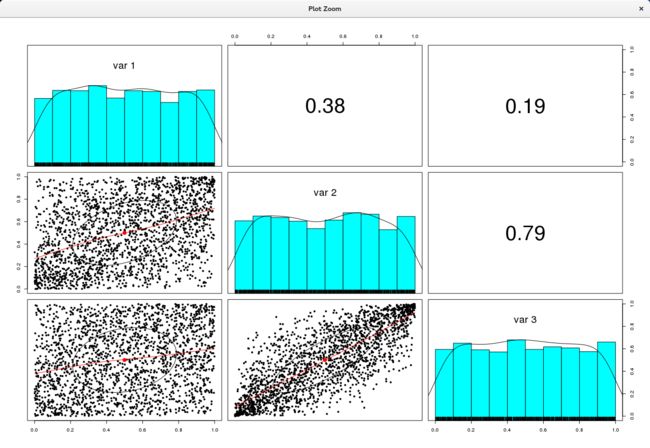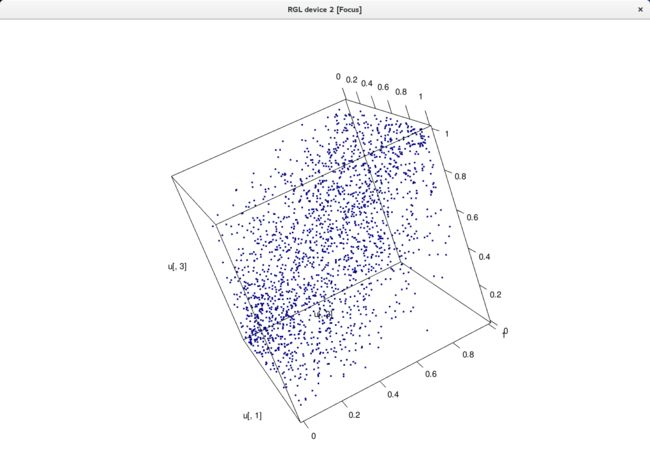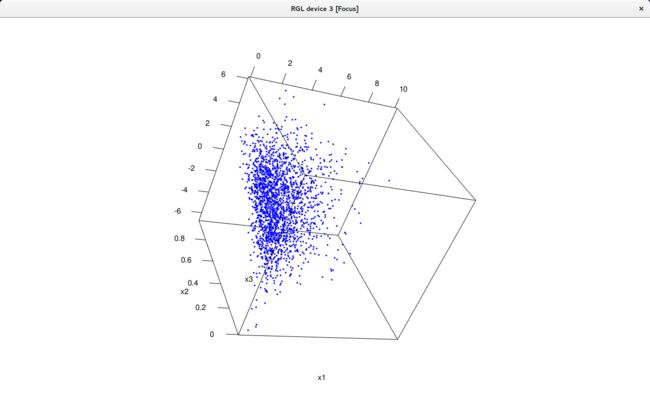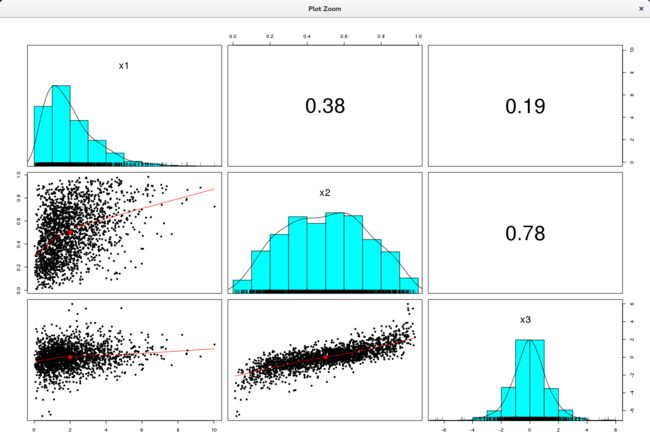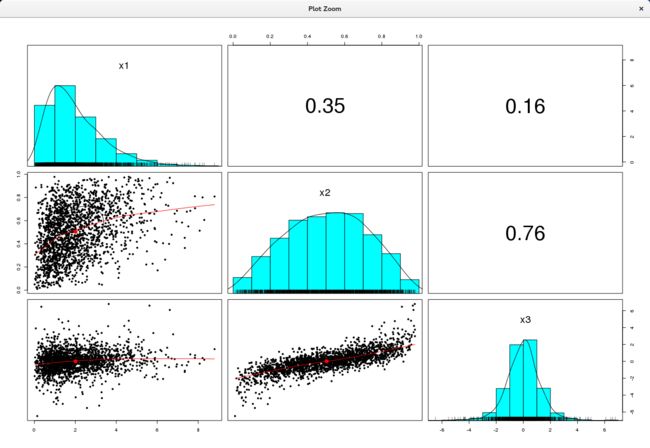- uni.request 发起网络请求3种回调结果调用
治金的blog
前端uni-app
第一种标题:{{item.title}}内容:{{item.body}}import{ref}from'vue';letarrs=ref([]);//uni.request请求的三种方式functionrequest(){uni.request({url:"https://jsonplaceholder.typicode.com/posts",success:res=>{console.log(r
- 一文读懂MUSIC算法DOA估计的数学原理并仿真
迎风打盹儿
阵列信号处理MUSIC算法DOA估计阵列信号处理信号子空间噪声子空间
一文读懂MUSIC算法DOA估计的数学原理并仿真文章目录前言一、DOA估计基本原理二、MATLAB仿真总结前言MUSIC(MultipleSignalClassification)算法于1979年由R.O.Schmidt提出,是阵列信号处理中广泛应用的经典DOA(DirectionofArrival)估计算法,凭借其超分辨的估计性能受到广泛关注。本文将从数学公式推导的角度出发系统阐述MUSIC算法
- Docker 部署AnythingLLM
炫爱小七
docker容器ai
两个指令搞定1.下载镜像dockerpullmintplexlabs/anythingllm2.运行容器exportSTORAGE_LOCATION=$HOME/anythingllmmkdir-p$STORAGE_LOCATIONchmod-R777$STORAGE_LOCATIONtouch"$STORAGE_LOCATION/.env"dockerrun-d-p3001:3001\--cap
- 华为昇腾服务器部署DeepSeek模型实战
gzroy
人工智能语言模型
在华为的昇腾服务器上部署了DeepSeekR1的模型进行验证测试,记录一下相关的过程。服务器是配置了8块910B3的显卡,每块显卡有64GB显存,根据DeepSeekR1各个模型的参数计算,如果部署R1的Qwen14B版本,需要1张显卡,如果是32B版本,需要2张,Llama70B的模型需要4张显卡。如果是R1全参数版本,则需要32张显卡,也就是4台满配的昇腾服务器。这里先选择32B的模型进行部署
- 《数组》学习——有序数组的平方
小翔很开心
我在CSDN学算法学习
有序数组的平方题目:给你一个按非递减顺序排序的整数数组nums,返回每个数字的平方组成的新数组,要求也按非递减顺序排序。测试用例:输入:nums=[-4,-1,0,3,10]输出:[0,1,9,16,100]解释:平方后,数组变为[16,1,0,9,100],排序后,数组变为[0,1,9,16,100]该题,有两种解法:暴力排序解法双指针法(快慢指针法)测试程序:(双指针法的求解)#include
- 【练习】【二分】力扣热题100 34. 在排序数组中查找元素的第一个和最后一个位置
柠石榴
输入输出力扣hot100leetcode算法c++二分
题目给你一个按照非递减顺序排列的整数数组nums,和一个目标值target。请你找出给定目标值在数组中的开始位置和结束位置。如果数组中不存在目标值target,返回[-1,-1]。你必须设计并实现时间复杂度为O(logn)的算法解决此问题。示例1:输入:nums=[5,7,7,8,8,10],target=8输出:[3,4]示例2:输入:nums=[5,7,7,8,8,10],target=6输出
- 34、深度学习-自学之路-深入理解-NLP自然语言处理-RNN一个简单的程序,可以从程序中理解RNN的基本思想。
小宇爱
深度学习-自学之路深度学习自然语言处理rnn
importsys,random,mathfromcollectionsimportCounterimportnumpyasnpf=open('tasks_1-20_v1/en/qa1_single-supporting-fact_train.txt','r')raw=f.readlines()f.close()tokens=list()forlineinraw[0:1000]:tokens.ap
- DeepSeek-R1 技术全景解析:从原理到实践的“炼金术配方” ——附多阶段训练流程图与核心误区澄清...
雪停时偶遇一叶春
流程图
合集-人工智能(5)1.如何改进AI模型在特定环境中的知识检索2024-09-242.深度学习与统计学中的时间序列预测2024-10-033.《使用coze搭建一个会搜索、写ppt、思维导图的Agent》2024-10-294.深入浅出:Agent如何调用工具——从OpenAIFunctionCall到CrewAI框架01-145.DeepSeek-R1技术全景解析:从原理到实践的“炼金术配方”—
- centos操作系统安装R包单细胞拟时序分析CytoTRACE2
探序基因
centoslinux运维
探序基因肿瘤研究院整理作者操作系统为centosstream8,R版本为4.3.3devtools::install_github("digitalcytometry/cytotrace2",subdir="cytotrace2_r")中途出现错误:*installing*source*package‘RcppGSL’...**成功将‘RcppGSL’程序包解包并MD5和检查**usingstag
- 2025年2月9日(数据分析_2)
Mason Lin
Python学习数据分析数据挖掘
散点图frommatplotlibimportpyplotaspltfrommatplotlibimportfont_manager#字体相关#字体font_path=r"C:\Windows\Fonts\msyh.ttc"my_font=font_manager.FontProperties(fname=font_path)x=list(range(31))x2=list(range(31,62
- Ubuntu终端常用快捷键总结
机器人那些事儿
开发环境ubuntu
基本导航快捷键:Ctrl+A:将光标移到行首Ctrl+E:将光标移到行尾Ctrl+U:删除光标前的所有字符Ctrl+K:删除光标后的所有字符Ctrl+L:清屏(相当于执行clear命令)编辑命令行:Ctrl+W:删除光标前的一个单词Ctrl+Y:粘贴之前使用Ctrl+U或Ctrl+K删除的文本Ctrl+_:撤销上一步的操作历史命令:Ctrl+R:逆向搜索历史命令Ctrl+G:退出历史命令搜索模式C
- Playwright 入门介绍和使用指南
IT鱼多多
Python基础#Python接口测试框架python开发语言Playwright
Playwright入门介绍,Playwright使用指南请参考另一篇博客此博客为Playwright官网:译文希望让读者可以快速了解Playwriht可以用来做什么,怎么用。有些专业名词可能翻译不准确哈文章目录1.入门1.1Installation安装1.1.1AddExampleTest添加示例测试1.1.2RunningtheExampleTest运行示例测试1.2WritingTests编
- DeepSeek原理介绍以及对网络安全行业的影响
AI拉呱
Deepseek人工智能
大家好,我是AI拉呱,一个专注于人工智领域与网络安全方面的博主,现任资深算法研究员一职,兼职硕士研究生导师;热爱机器学习和深度学习算法应用,深耕大语言模型微调、量化、私域部署。曾获多次获得AI竞赛大奖,拥有多项发明专利和学术论文。对于AI算法有自己独特见解和经验。曾辅导十几位非计算机学生转行到算法岗位就业。关注评审分享一起学习更多知识。1.DeepSeek公司介绍1.1DeepSeek是什么:wh
- 【数据分析】通过个体和遗址层面的遗传相关性网络分析
生信学习者1
数据分析数据分析数据挖掘r语言数据可视化
禁止商业或二改转载,仅供自学使用,侵权必究,如需截取部分内容请后台联系作者!文章目录介绍原理应用场景加载R包数据下载函数个体层面的遗传相关性网络分析导入数据数据预处理构建遗传相关性的个体网络对个体网络Nij进行可视化评估和选择最佳模型评估和选择最佳模型最佳模型进行总结拟合优度检验遗址层面的遗传相关性网络分析导入数据数据预处理构建遗址之间的遗传相关性网络可视化图条件边预测与模型评估总结系统信息介绍个
- 大模型(含deepseek r1)本地部署利器ollama的API操作指南
人工智能llm
ollama介绍:Ollama是一个开源的大型语言模型(LLM)平台,旨在让用户能够轻松地在本地运行、管理和与大型语言模型进行交互。它支持多种预训练的大型语言模型(如LLaMA2、Mistral、Gemma、DeepSeek等),并提供了一个简单高效的方式来加载和使用这些模型。出现Error:somethingwentwrong,pleaseseetheollamaserverlogsfordet
- 【系统设计】忘记MySQL密码,应该如何重置
红烧白开水。
mysql数据库开发语言数据关系型数据库密码重置
如果在电脑上安装的MySQL数据库忘记了密码,可以通过以下步骤重置密码。具体操作因操作系统和MySQL版本略有不同,但总体流程类似:步骤1:停止MySQL服务首先需要停止正在运行的MySQL服务。Linux/macOSsudosystemctlstopmysql#或sudoservicemysqlstopWindows按Win+R,输入services.msc并回车。找到MySQL服务,右键选择停
- 《DeepSeek-R1 vs ChatGPT-4:AI大模型“王座争夺战”的终极拆解报告》
Athena-H
LLM人工智能gptchatgptai
引言:大模型时代的双雄博弈在生成式AI爆发式迭代的今天,DeepSeek-R1与ChatGPT-4分别以“中国智造新锐”与“全球标杆王者”的身份,掀起技术路线与应用生态的激烈碰撞。本文从架构设计、场景适配、性能极限三大维度,揭示两大模型的真实战力图谱。一、核心技术架构:差异化路线对决对比维度DeepSeek-R1ChatGPT-4模型架构多模态混合专家模型(MoE+Transformer)纯Dec
- 文件与目录操作函数详解
归零 dddd
c语言linux算法
在编程中,文件和目录操作是常见的任务。本文将详细讲解常用的文件操作函数和目录操作函数,包括其功能、参数、使用方法,并通过示例代码展示如何用这些函数实现常见的操作。文件操作函数1.1fopen()函数功能:打开或创建文件。参数:constchar*pathname:文件名。constchar*mode:文件操作模式。常见的模式有:"r":只读模式,文件必须存在。"w":只写模式,文件不存在则创建,存
- idea快捷键
yiqi_perss
日常intellij-ideajavaide
idea快捷键ctrl+`可以切换界面CTRL快捷键介绍Ctrl+`切换界面Ctrl+E打开最近访问的文件Ctrl+shift+e打开你最近编辑的文本Ctrl+R在当前文件进行文本替换(必备)Ctrl+F在当前文件进行文本查找(必备)Ctrl+Z撤销(必备)Ctrl+Y删除光标所在行或删除选中的行(必备)Ctrl+X剪切光标所在行或剪切选择内容Ctrl+C复制光标所在行或复制选择内容Ctrl+D复
- 运维分级发布_运维必备制度:故障分级和处罚规范
weixin_39599046
运维分级发布
正文互联网产品提供7*24小时服务,而因人为操作、程序BUG等原因导致服务不可用是影响服务持续运行的重要原因,为了提高各业务产品的运维和运营质量,规范各业务线的服务、故障响应,拟定和发布“故障分级和处罚规范”是非常必要的。故障分级标准运营故障中,对非不可抗力所造成的故障归类为“故障”,对于故障将追究故障的分级,故障责任人,及故障处理结果。下面将就各类故障级别进行定义说明,由于故障可能在多方面体现影
- 1002:方便记忆的电话号码
努力的小Qin
1002:方便记忆的电话号总时间限制:2000ms内存限制:65536kB描述英文字母(除Q和Z外)和电话号码存在着对应关系,如下所示:A,B,C->2D,E,F->3G,H,I->4J,K,L->5M,N,O->6P,R,S->7T,U,V->8W,X,Y->9标准的电话号码格式是xxx-xxxx,其中x表示0-9中的一个数字。有时为了方便记忆电话号码,我们会将电话号码的数字转变为英文字母,如把
- vue3+vite 自动引入export default的包
大橙子-
vue.js前端
importautoImportfrom'unplugin-auto-import/vite';exportdefaultdefineConfig({plugins:[vue(),vueJsx(),autoImport({imports:['vue','vue-router','pinia',{//相当于importuseRouterStackStorefrom'@/store/modules/r
- mysql不生成socket_不能创建 mysql.sock.lock是怎么回事
莉莉莉莉酱
mysql不生成socket
展开全部一、原因:1、linux系统一62616964757a686964616fe78988e69d8331333363356533次不正常关机后,连接mysql的时候系统提示不能通过/tmp/mysql.sock文件进行连接,或者非正确关闭时,导致mysql.sock文件再次丢失,当你在次启动时出现如下错误,connectmysqldfaild,/tmp/mysql.sockcan'tfind
- 力扣hot100——42.接雨水
码凡
leetcode算法
42.接雨水给定n个非负整数表示每个宽度为1的柱子的高度图,计算按此排列的柱子,下雨之后能接多少雨水。示例1:输入:height=[0,1,0,2,1,0,1,3,2,1,2,1]输出:6解释:上面是由数组[0,1,0,2,1,0,1,3,2,1,2,1]表示的高度图,在这种情况下,可以接6个单位的雨水(蓝色部分表示雨水)。示例2:输入:height=[4,2,0,3,2,5]输出:9提示:n==
- 零基础学Python图片处理:用Pillow库轻松玩转修图
小彭爱学习
pythonpythonpillowpython处理图片
零基础学Python图片处理:用Pillow库轻松玩转修图一、初识Pillow:你的第一张数码暗房安装准备(只需要1分钟)打开电脑的命令行(Windows按Win+R输入cmd,Mac打开终端),输入:pipinstallpillow看到「SuccessfullyinstalledPillow-x.x.x」就安装成功啦!图片处理四步走打开图片:像打开文件柜一样找到图片修改图片:裁剪、调色、加特效查
- win11系统亮度调节显示条存在,调节失效的问题解决及补充
Luis Li 的猫猫
windows
屏幕突然无法调节亮度,按键盘上的亮度调节快捷键没反应,点击右下角电源打开亮度调节,进入设置-系统-屏幕里有亮度调节的栏,滑动但不改变亮度。没有亮度条是显示卡驱动丢失根据目前CSDN所提出的主流方式以及线下售后门店人员所提供的解决方案1.设备管理器更新显示卡驱动(核显2.更新显示屏(监视器)驱动3.禁用显卡后更新显示屏驱动4.检查监视器是否为“通用即插即用”不是“非通用xx”5.上述操作后均要重启电
- 【Java】逻辑运算符详解:&&、|| 与&、 | 的区别及应用
小ᶻ☡꙳ᵃⁱᵍᶜ꙳
springboot
博客主页:[小ᶻ☡꙳ᵃⁱᵍᶜ꙳]本文专栏:Java文章目录前言一、基本概念与运算符介绍二、短路与与非短路与:&&与&的区别1.`&&`:短路与(AND)2.`&`:非短路与(AND)三、短路或与非短路或:||与|的区别1.`||`:短路或(OR)2.`|`:非短路或(OR)四、总结:什么时候使用短路与非短路运算符五、拓展:短路与非短路运算符的副作用六、结论前言在Java编程中,逻辑运算符是非常常见
- ansible部署ceph
时空无限
cephansiblecephlinux
前言:ceph的官网有坑。按照官网部署,不会一蹴而就。会遇到各种各样的问题,ceph文档有待改进。环境操作系统cat/etc/redhat-releaseCentOSLinuxrelease8.5.2111uname-r4.18.0-80.el8.x86_64主机名三台主机,其中node-01为部署机器和ceph的其中一个节点。node-01node-02node-03网卡和ip每台主机双网卡en
- 本地运行 DeepSeek-R1 的成本究竟多高?
前端javascript
ReactHook深入浅出CSS技巧与案例详解vue2与vue3技巧合集VueUse源码解读本地运行DeepSeek-R1的成本究竟多高?DeepSeek让人们对大规模生成式模型的追求更进一步,甚至有人想在本地跑下规模高达671B参数的版本。但要在家里开这种“巨无霸”,可不是闹着玩的:光是推理就对硬件提出了非常高的要求。这篇文章将大致拆解一下,如果真想在个人电脑上运行DeepSeek-R1,可能需
- R语言中的函数32:seq_along()
zoujiahui_2018
#R语言中的函数r语言开发语言
介绍seq_along函数在R语言中用于生成一个整数序列,其长度与给定对象的长度相同。这个函数特别有用,当你想要创建一个索引序列来遍历一个向量或列表时。用法seq_along(x)参数x:任何R对象(如向量、列表等)。返回值:返回一个从1到x的长度的整数序列。示例#创建一个向量vec<-c("a","b","c")#使用seq_along生成索引indices<-seq_along(vec)pri
- 面向对象面向过程
3213213333332132
java
面向对象:把要完成的一件事,通过对象间的协作实现。
面向过程:把要完成的一件事,通过循序依次调用各个模块实现。
我把大象装进冰箱这件事为例,用面向对象和面向过程实现,都是用java代码完成。
1、面向对象
package bigDemo.ObjectOriented;
/**
* 大象类
*
* @Description
* @author FuJian
- Java Hotspot: Remove the Permanent Generation
bookjovi
HotSpot
openjdk上关于hotspot将移除永久带的描述非常详细,http://openjdk.java.net/jeps/122
JEP 122: Remove the Permanent Generation
Author Jon Masamitsu
Organization Oracle
Created 2010/8/15
Updated 2011/
- 正则表达式向前查找向后查找,环绕或零宽断言
dcj3sjt126com
正则表达式
向前查找和向后查找
1. 向前查找:根据要匹配的字符序列后面存在一个特定的字符序列(肯定式向前查找)或不存在一个特定的序列(否定式向前查找)来决定是否匹配。.NET将向前查找称之为零宽度向前查找断言。
对于向前查找,出现在指定项之后的字符序列不会被正则表达式引擎返回。
2. 向后查找:一个要匹配的字符序列前面有或者没有指定的
- BaseDao
171815164
seda
import java.sql.Connection;
import java.sql.DriverManager;
import java.sql.SQLException;
import java.sql.PreparedStatement;
import java.sql.ResultSet;
public class BaseDao {
public Conn
- Ant标签详解--Java命令
g21121
Java命令
这一篇主要介绍与java相关标签的使用 终于开始重头戏了,Java部分是我们关注的重点也是项目中用处最多的部分。
1
- [简单]代码片段_电梯数字排列
53873039oycg
代码
今天看电梯数字排列是9 18 26这样呈倒N排列的,写了个类似的打印例子,如下:
import java.util.Arrays;
public class 电梯数字排列_S3_Test {
public static void main(S
- Hessian原理
云端月影
hessian原理
Hessian 原理分析
一. 远程通讯协议的基本原理
网络通信需要做的就是将流从一台计算机传输到另外一台计算机,基于传输协议和网络 IO 来实现,其中传输协议比较出名的有 http 、 tcp 、 udp 等等, http 、 tcp 、 udp 都是在基于 Socket 概念上为某类应用场景而扩展出的传输协
- 区分Activity的四种加载模式----以及Intent的setFlags
aijuans
android
在多Activity开发中,有可能是自己应用之间的Activity跳转,或者夹带其他应用的可复用Activity。可能会希望跳转到原来某个Activity实例,而不是产生大量重复的Activity。
这需要为Activity配置特定的加载模式,而不是使用默认的加载模式。 加载模式分类及在哪里配置
Activity有四种加载模式:
standard
singleTop
- hibernate几个核心API及其查询分析
antonyup_2006
html.netHibernatexml配置管理
(一) org.hibernate.cfg.Configuration类
读取配置文件并创建唯一的SessionFactory对象.(一般,程序初始化hibernate时创建.)
Configuration co
- PL/SQL的流程控制
百合不是茶
oraclePL/SQL编程循环控制
PL/SQL也是一门高级语言,所以流程控制是必须要有的,oracle数据库的pl/sql比sqlserver数据库要难,很多pl/sql中有的sqlserver里面没有
流程控制;
分支语句 if 条件 then 结果 else 结果 end if ;
条件语句 case when 条件 then 结果;
循环语句 loop
- 强大的Mockito测试框架
bijian1013
mockito单元测试
一.自动生成Mock类 在需要Mock的属性上标记@Mock注解,然后@RunWith中配置Mockito的TestRunner或者在setUp()方法中显示调用MockitoAnnotations.initMocks(this);生成Mock类即可。二.自动注入Mock类到被测试类 &nbs
- 精通Oracle10编程SQL(11)开发子程序
bijian1013
oracle数据库plsql
/*
*开发子程序
*/
--子程序目是指被命名的PL/SQL块,这种块可以带有参数,可以在不同应用程序中多次调用
--PL/SQL有两种类型的子程序:过程和函数
--开发过程
--建立过程:不带任何参数
CREATE OR REPLACE PROCEDURE out_time
IS
BEGIN
DBMS_OUTPUT.put_line(systimestamp);
E
- 【EhCache一】EhCache版Hello World
bit1129
Hello world
本篇是EhCache系列的第一篇,总体介绍使用EhCache缓存进行CRUD的API的基本使用,更细节的内容包括EhCache源代码和设计、实现原理在接下来的文章中进行介绍
环境准备
1.新建Maven项目
2.添加EhCache的Maven依赖
<dependency>
<groupId>ne
- 学习EJB3基础知识笔记
白糖_
beanHibernatejbosswebserviceejb
最近项目进入系统测试阶段,全赖袁大虾领导有力,保持一周零bug记录,这也让自己腾出不少时间补充知识。花了两天时间把“传智播客EJB3.0”看完了,EJB基本的知识也有些了解,在这记录下EJB的部分知识,以供自己以后复习使用。
EJB是sun的服务器端组件模型,最大的用处是部署分布式应用程序。EJB (Enterprise JavaBean)是J2EE的一部分,定义了一个用于开发基
- angular.bootstrap
boyitech
AngularJSAngularJS APIangular中文api
angular.bootstrap
描述:
手动初始化angular。
这个函数会自动检测创建的module有没有被加载多次,如果有则会在浏览器的控制台打出警告日志,并且不会再次加载。这样可以避免在程序运行过程中许多奇怪的问题发生。
使用方法: angular .
- java-谷歌面试题-给定一个固定长度的数组,将递增整数序列写入这个数组。当写到数组尾部时,返回数组开始重新写,并覆盖先前写过的数
bylijinnan
java
public class SearchInShiftedArray {
/**
* 题目:给定一个固定长度的数组,将递增整数序列写入这个数组。当写到数组尾部时,返回数组开始重新写,并覆盖先前写过的数。
* 请在这个特殊数组中找出给定的整数。
* 解答:
* 其实就是“旋转数组”。旋转数组的最小元素见http://bylijinnan.iteye.com/bl
- 天使还是魔鬼?都是我们制造
ducklsl
生活教育情感
----------------------------剧透请原谅,有兴趣的朋友可以自己看看电影,互相讨论哦!!!
从厦门回来的动车上,无意中瞟到了书中推荐的几部关于儿童的电影。当然,这几部电影可能会另大家失望,并不是类似小鬼当家的电影,而是关于“坏小孩”的电影!
自己挑了两部先看了看,但是发现看完之后,心里久久不能平
- [机器智能与生物]研究生物智能的问题
comsci
生物
我想,人的神经网络和苍蝇的神经网络,并没有本质的区别...就是大规模拓扑系统和中小规模拓扑分析的区别....
但是,如果去研究活体人类的神经网络和脑系统,可能会受到一些法律和道德方面的限制,而且研究结果也不一定可靠,那么希望从事生物神经网络研究的朋友,不如把
- 获取Android Device的信息
dai_lm
android
String phoneInfo = "PRODUCT: " + android.os.Build.PRODUCT;
phoneInfo += ", CPU_ABI: " + android.os.Build.CPU_ABI;
phoneInfo += ", TAGS: " + android.os.Build.TAGS;
ph
- 最佳字符串匹配算法(Damerau-Levenshtein距离算法)的Java实现
datamachine
java算法字符串匹配
原文:http://www.javacodegeeks.com/2013/11/java-implementation-of-optimal-string-alignment.html------------------------------------------------------------------------------------------------------------
- 小学5年级英语单词背诵第一课
dcj3sjt126com
englishword
long 长的
show 给...看,出示
mouth 口,嘴
write 写
use 用,使用
take 拿,带来
hand 手
clever 聪明的
often 经常
wash 洗
slow 慢的
house 房子
water 水
clean 清洁的
supper 晚餐
out 在外
face 脸,
- macvim的使用实战
dcj3sjt126com
macvim
macvim用的是mac里面的vim, 只不过是一个GUI的APP, 相当于一个壳
1. 下载macvim
https://code.google.com/p/macvim/
2. 了解macvim
:h vim的使用帮助信息
:h macvim
- java二分法查找
蕃薯耀
java二分法查找二分法java二分法
java二分法查找
>>>>>>>>>>>>>>>>>>>>>>>>>>>>>>>>>>>>>>
蕃薯耀 2015年6月23日 11:40:03 星期二
http:/
- Spring Cache注解+Memcached
hanqunfeng
springmemcached
Spring3.1 Cache注解
依赖jar包:
<!-- simple-spring-memcached -->
<dependency>
<groupId>com.google.code.simple-spring-memcached</groupId>
<artifactId>simple-s
- apache commons io包快速入门
jackyrong
apache commons
原文参考
http://www.javacodegeeks.com/2014/10/apache-commons-io-tutorial.html
Apache Commons IO 包绝对是好东西,地址在http://commons.apache.org/proper/commons-io/,下面用例子分别介绍:
1) 工具类
2
- 如何学习编程
lampcy
java编程C++c
首先,我想说一下学习思想.学编程其实跟网络游戏有着类似的效果.开始的时候,你会对那些代码,函数等产生很大的兴趣,尤其是刚接触编程的人,刚学习第一种语言的人.可是,当你一步步深入的时候,你会发现你没有了以前那种斗志.就好象你在玩韩国泡菜网游似的,玩到一定程度,每天就是练级练级,完全是一个想冲到高级别的意志力在支持着你.而学编程就更难了,学了两个月后,总是觉得你好象全都学会了,却又什么都做不了,又没有
- 架构师之spring-----spring3.0新特性的bean加载控制@DependsOn和@Lazy
nannan408
Spring3
1.前言。
如题。
2.描述。
@DependsOn用于强制初始化其他Bean。可以修饰Bean类或方法,使用该Annotation时可以指定一个字符串数组作为参数,每个数组元素对应于一个强制初始化的Bean。
@DependsOn({"steelAxe","abc"})
@Comp
- Spring4+quartz2的配置和代码方式调度
Everyday都不同
代码配置spring4quartz2.x定时任务
前言:这些天简直被quartz虐哭。。因为quartz 2.x版本相比quartz1.x版本的API改动太多,所以,只好自己去查阅底层API……
quartz定时任务必须搞清楚几个概念:
JobDetail——处理类
Trigger——触发器,指定触发时间,必须要有JobDetail属性,即触发对象
Scheduler——调度器,组织处理类和触发器,配置方式一般只需指定触发
- Hibernate入门
tntxia
Hibernate
前言
使用面向对象的语言和关系型的数据库,开发起来很繁琐,费时。由于现在流行的数据库都不面向对象。Hibernate 是一个Java的ORM(Object/Relational Mapping)解决方案。
Hibernte不仅关心把Java对象对应到数据库的表中,而且提供了请求和检索的方法。简化了手工进行JDBC操作的流程。
如
- Math类
xiaoxing598
Math
一、Java中的数字(Math)类是final类,不可继承。
1、常数 PI:double圆周率 E:double自然对数
2、截取(注意方法的返回类型) double ceil(double d) 返回不小于d的最小整数 double floor(double d) 返回不大于d的整最大数 int round(float f) 返回四舍五入后的整数 long round
